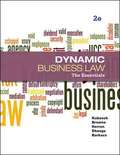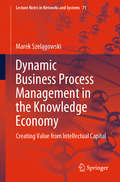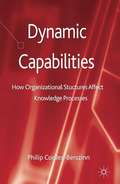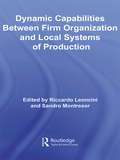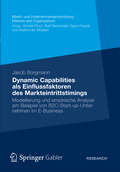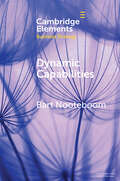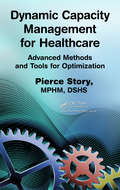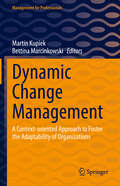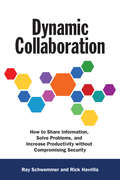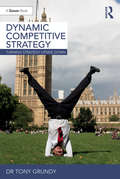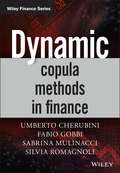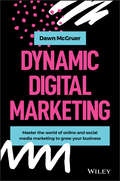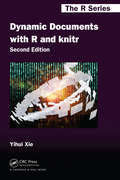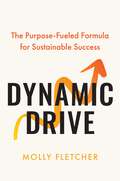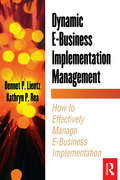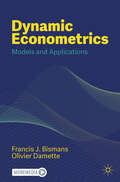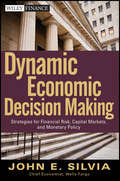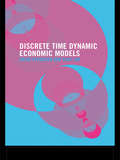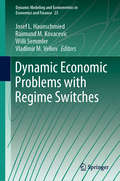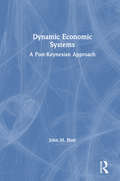- Table View
- List View
Dynamic Analysis in Complex Economic Environments: Essays in Honor of Christophe Deissenberg (Dynamic Modeling and Econometrics in Economics and Finance #26)
by Herbert Dawid Jasmina ArifovicThis book analyses decision-making in dynamic economic environments. By applying a wide range of methodological approaches, combining both analytical and computational methods, the contributors examine various aspects of optimal firm behaviour and relevant policy areas. Topics covered include optimal control, dynamic games, economic decision-making, and applications in finance and economics, as well as policy implications in areas such as pollution regulation. This book is dedicated to Christophe Deissenberg, a well-known and distinguished scholar of economic dynamics and computational economics. It appeals to academics in the areas of optimal control, dynamic games and computational economics as well as to decision-makers working in policy domains such as environmental policy.
Dynamic Approaches to Global Economic Challenges
by Birgit Bednar-Friedl Jörn KleinertThis book addresses three big economic challenges from a dynamic perspective: European integration, economic growth, and global climate change. In the light of the recent crises of the European Union (EU), the first part of the book deals with challenges to the real, monetary and fiscal integration of the EU and required institutional adjustments. The second part of the book addresses fundamental challenges of advanced market economies like economic growth and changes of technologies. The final part focuses on the global challenge of climate change from an economic perspective and discusses policy strategies for a successful mitigation of climate change.
Dynamic Business Law: The Essentials
by Nancy Kubasek Linda Barkacs Lucien Dhooge M. Browne Daniel HerronDynamic Business Law: The Essentials is appropriate for the one-semester Business Law course. It contains the basics of business law but does not get bogged down in the kind of details that are more appropriate in an upper-level law class. The text provides an examination of the basic questions, concepts, and legal rules of business law. Emphasis on the BUSINESS in business law. Dynamic Business Law: The Essentials emphasizes the tie of legal issues back to the core business curriculum. This will help both students and faculty. Faculty need to know how this is integrated as they are constantly 'defending' the inclusion of this course in the business curriculum. And students need to understand how the concepts tie to their future business careers. Emphasis on TEACHING. Many professors teaching this course are attorneys first and academics second. They do not have a lot of time to prepare or think about how to apply this information effectively for their business students. Dynamic Business Law: The Essentials contains a helpful instructor's manual, particularly for the many adjuncts teaching this course. Emphasis on CRITICAL THINKING. Neil Browne, one of the co-authors of this text, has written a successful text on critical thinking. His framework is included in Dynamic Business Law: The Essentials as well - to help students learn how to frame and reframe a question/issue. Critical thinking questions are also included at the end of each case, to tie in this component even further.
Dynamic Business Process Management in the Knowledge Economy: Creating Value from Intellectual Capital (Lecture Notes in Networks and Systems #71)
by Marek SzelągowskiThis book describes modern dynamic business process management (dynamic BPM), which is considerably different from traditional BPM from 20, 10, or even 5 years ago. It demonstrates why traditional BPM is not sufficient in the knowledge economy (KE), while also highlighting the opportunities provided by dynamic BPM – the form of management that practitioners and academics deal with on a daily basis. This involves mastering and implementing e.g. case management, process mining, and RPA, and integrating them with knowledge management. But more importantly, dynamic BPM makes full use of the dynamism of knowledge workers: the people who actually create innovative products and services tailored to the specific needs of clients. The book was primarily written for those managers who see advantageous opportunities amidst the ongoing changes. Accordingly, it focuses more on innovations emerging from practice than on theoretical, academic reflection. In addition to helping organizations operating in the KE to prepare for and implement process management, the book is intended as a source of inspiration for process management researchers and iBPMS system vendors.
Dynamic Capabilities
by Philip Cordes-BerszinnThe concept of dynamic capabilities, especially in terms of organizational knowledge processes, has become the predominant paradigm for the explanation of competitive advantages. However, major unsolved - or at least insufficiently solved - problems are first their measurement and second their management by concrete managerial options, such as design options of organizational structures. Dynamic Capabilities provides an integrated descriptive model of both dynamic capabilities and organizational structures that allows characterizing, classifying and a comparison. It develops a logic system of a multitude of combinatorial possibilities between their variables, and it develops a complex and integrated system of associated empirically based and qualitatively deduced hypotheses. Therewith, it serves as a terminological and analytical foundation for the identification of knowledge-based dynamic capabilities in organizations and for a targeted design of organizational structures that enable and foster dynamic capability processes such as knowledge transfer and knowledge absorption.
Dynamic Capabilities Between Firm Organisation and Local Systems of Production (Routledge Studies In Global Competition Ser.)
by Riccardo Leoncini Sandro MontresorChanges in technology and demand require firms to learn how to continuously reshape unique and non-imitable resources and competences. A firm‘s capacity to achieve this is captured by the concept of dynamic capabilities. This book offers an analysis of how firms manage to reconfigure their pool of idiosyncratic resources, skills and competencies to
Dynamic Capabilities als Einflussfaktoren des Markteintrittstimings
by Jakob BorgmannSeit Jahrzehnten wird sowohl in der betriebswirtschaftlichen Forschung als auch in der Wirtschaftspraxis leidenschaftlich die Frage diskutiert: Sind Pioniere, frühe Folger oder gar späte Folger eines Marktsegments erfolgreicher? Völlig in den Hintergrund geraten ist dabei jedoch die für ein erfolgreiches Markteintrittstiming grundlegende Frage: Welche Faktoren führen überhaupt dazu, dass ein Unternehmen zum Pionier, frühen oder späten Folger wird? Jakob Borgmann identifiziert anhand eines theoretischen Rahmenwerks und plastisch illustrierter Fallstudien die Wirkung einzelner Einflussfaktoren auf das Markteintrittstiming im E-Business.
Dynamic Capabilities and Relationships: Discourses, Concepts, and Reflections (Contributions to Management Science)
by Jochen Koch Martin Eisend Tomás Bayón Albrecht Söllner Markus Vodosek Heinz-Theo WagnerBuilding on the seminal work of David Teece, Kathleen Eisenhardt, Jeffrey Martin, and others, this volume applies the concept of dynamic capabilities to help readers understand how organizations can be successful in highly dynamic environments. The contributions, written by researchers who participated in the research program "Dynamic Capabilities and Relationships" and international researchers who participated in the program’s international conference (both funded by the Dieter Schwarz Foundation), highlight state-of-the-art research on dynamic capabilities and relationships. They also put forward an integrated management approach for the purpose of understanding, analyzing, and managing the successful creation and adaptation of capabilities and relationships.
Dynamic Capabilities: History and an Extension (Elements in Business Strategy)
by Bart NooteboomThe development of salient ideas and publications on dynamic capabilities is given, extended by ideas outside the literature of strategic management. Dynamic capability is presented as an interdisciplinary subject to which knowledge is central. Diversity of knowledge is treated in terms of cognitive distance, limited through organisational focus. To deal with diversity, development and uncertainty, evolutionary theory and the notion of entropy are used. The relation between individual and organisational knowledge is modelled with the notion of a script and linguistic ideas. The governance of collaborative relations for innovation is discussed, including trust, which are also dynamic capabilities.
Dynamic Capacity Management for Healthcare: Advanced Methods and Tools for Optimization
by Pierce StoryWhile hospitals can learn from other industries, they cannot be improved or run like factories. With work that is more individualized than standardized, and limited control over volume and arrivals, even the leanest-minded hospital must recognize that healthcare systems are more dynamic than nearly any work environment.Written with the creativity n
Dynamic Change Management: A Context-oriented Approach to Foster the Adaptability of Organizations (Management for Professionals)
by Martin Kupiek Bettina MarcinkowskiThis book offers a new perspective on change projects in organizations. While traditional approaches of analysis, planning, and implementation can be too slow and unsatisfactory in dynamic environments, this book introduces a context-oriented, dynamic approach that seamlessly integrates technology, processes, and people into the organizational framework. Drawing from organizational theory, it prioritizes both the formal and informal aspects of an organization's structure and culture, and emphasizes the emotional side of change. It provides practical guidance on using emotion concepts to facilitate change in a positive way, and covers key supporting technologies, communication strategies, and human resource considerations. In addition to describing the approach, the book provides helpful tips on selecting the right consultants and embedding change know-how for future initiatives. It is an indispensable resource for anyone leading a change project or looking to improve their organization's ability to adapt. So why settle for a traditional approach when you can achieve meaningful change through a dynamic, context-oriented approach?
Dynamic Collaboration: How to Share Information, Solve Problems, and Increase Productivity without Compromising Security
by Ray Schwemmer Rick HavrillaCollaboration is crucial for any kind of organization that wants to be productive, adaptable, and creative. When people are collaborating, profits increase and things get done. When they're not, your organization loses time and energy. Why, then, do many private enterprises and government agencies struggle to provide collaboration tools their employees will actually use? Dynamic Collaboration offers practical advice to help you answer questions like these: - What tools does your organization need to help facilitate collaboration? - How do you ensure that your personnel will use those tools? - How can you protect your privileged information? - How can you harness the power of Web 2.0 and use it to capture the collective intelligence of your organization? Whether you are a leader in the public or private sector or a technologist, you'll discover ways to help team members solve problems they wouldn't otherwise have solved, get work done quicker than ever before, and feel connected because they are working together toward a common goal. "We are witnessing a transformation of collaboration in real time, and there's no better factual content than what Schwemmer and Havrilla have compiled in this book. Having spent time as a CIO at three different government agencies, I recommend this as required reading for those serious about collaboration." --Barry C. West, Executive Vice President, SE Solutions, Inc., and former CIO, US Department of Commerce
Dynamic Competitive Strategy: Turning Strategy Upside Down
by Tony Dr GrundyDynamic Competitive Strategy by best –selling author Dr Tony Grundy casts a radically new light on Competitive Strategy by showing you the dynamic dimension of existing strategy tools and new ones created to deal with rapid innovation and turbulent change. He shows us refreshing and challenging ways of developing strategy, including: Agile approaches to Strategy and Planning The art of the Cunning Plan –with 101 ways of being innovative The alien approach: how might an alien see your industry and business? A whole new set of dynamic strategy tools Scenario storytelling and the art of mental time travel How emotional value can leverage competitive advantag Dynamic stakeholder analysis and influencing He also includes case studies of Arsenal, Brexit, Dyson, Metrobank, Tesco, the infamous honey badger and others from everyday life. This book provides an overall theory and a wealth of practical guidance based on 30 years of Strategy Consulting and Management Research and Teaching that will transform your thinking about strategy. Tony truly "turns strategy upside down," as he does on the cover.
Dynamic Copula Methods in Finance
by Umberto Cherubini Sabrina Mulinacci Silvia Romagnoli Fabio GobbiThe latest tools and techniques for pricing and risk managementThis book introduces readers to the use of copula functions to represent the dynamics of financial assets and risk factors, integrated temporal and cross-section applications. The first part of the book will briefly introduce the standard the theory of copula functions, before examining the link between copulas and Markov processes. It will then introduce new techniques to design Markov processes that are suited to represent the dynamics of market risk factors and their co-movement, providing techniques to both estimate and simulate such dynamics. The second part of the book will show readers how to apply these methods to the evaluation of pricing of multivariate derivative contracts in the equity and credit markets. It will then move on to explore the applications of joint temporal and cross-section aggregation to the problem of risk integration.
Dynamic Digital Marketing: Master the world of online and social media marketing to grow your business
by Dawn McGruer8 powerful ways to market your business online to consistently generate an abundance of leads that convert into profitable customers. Dynamic Digital Marketing teaches any business or individual how to increase online visibility and presence, attract their target audience, generate leads, and convert them into profitable customers. Author Dawn McGruer is an expert at making businesses and brands shine online. She is passionate about helping entrepreneurs and businesses maximise their digital marketing profits by developing digital skills which scale and grow their businesses and accelerate their success. Most entrepreneurs and businesses fully understand the importance of digital marketing, yet many do not know where to start or, worse, continue to spend time, money, and effort on strategies that fail to provide the best results for their investment. To remedy this situation, Dawn developed her multi-award-winning digital marketing framework, Dynamic Digital Marketing Model. Offering step-by-step guidance, this book shows you how to use this model to market your business online whilst transforming yourself into a proficient digital marketer. This must-read book will help you: Gain invaluable insights on what works – and what doesn’t – based on the author’s 20 years’ experience in digital marketing Avoid pitfalls and missteps by implementing the same proven success strategies used by key influencers Harness the power of search engine optimisation (SEO), social media, content marketing, online video, and more Amplify your brand, cultivate customers, and increase profits Incorporate e-mail marketing, customer analytics, strategic web design, and influencer partnerships in your overall digital marketing strategy Dynamic Digital Marketing: Master the world of online and social media marketing to grow your business is an indispensable resource for business leaders, business owners, marketing and sales professionals, digital strategists and consultants, entrepreneurs, and students in business and marketing programmes.
Dynamic Documents with R and knitr (Chapman & Hall/CRC The R Series #12)
by Yihui XieQuickly and Easily Write Dynamic Documents Suitable for both beginners and advanced users, Dynamic Documents with R and knitr, Second Edition makes writing statistical reports easier by integrating computing directly with reporting. Reports range from homework, projects, exams, books, blogs, and web pages to virtually any documents related to statistical graphics, computing, and data analysis. The book covers basic applications for beginners while guiding power users in understanding the extensibility of the knitr package. New to the Second Edition A new chapter that introduces R Markdown v2 Changes that reflect improvements in the knitr package New sections on generating tables, defining custom printing methods for objects in code chunks, the C/Fortran engines, the Stan engine, running engines in a persistent session, and starting a local server to serve dynamic documents Boost Your Productivity in Statistical Report Writing and Make Your Scientific Computing with R Reproducible Like its highly praised predecessor, this edition shows you how to improve your efficiency in writing reports. The book takes you from program output to publication-quality reports, helping you fine-tune every aspect of your report.
Dynamic Drive: The Purpose-Fueled Formula for Sustainable Success
by Molly FletcherIn a world fixated on fleeting success, Molly Fletcher, renowned keynote speaker, podcast host, and entrepreneur, invites you to challenge the status quo and redefine your understanding of drive so that you can achieve greater fulfillment and purpose-driven success. This isn&’t just another self-help theory: Dynamic Drive is your practical guide to unlocking your true potential. Through her decades of experience working with top athletes and peak performers across industries, renowned keynote speaker and leadership expert Molly Fletcher has created a proven formula backed by research that outlines the seven keys to sustainable success. The truth is fulfillment doesn&’t come from setting and accomplishing goals in isolation. It comes from Dynamic Drive—a holistic approach that connects all parts of you with your purpose and allows you to engage in meaningful growth, both personally and professionally. Unlike traditional approaches that dilute drive into a mere means to an end, which can lead to burnout, Dynamic Drive is a way of life, a mindset. It&’s about figuring out the parts of your life where you are playing small or safe or are dissatisfied. Dynamic Drive is the process by which we implement and sustain intentional change. The greatest reward isn&’t in what you achieve, but who you become in the process. Your path to sustained high performance in all areas of your life begins here. This is your manual for an aligned, joyful, and relentless pursuit of a better you.
Dynamic E-Business Implementation Management
by Bennet Lientz Kathryn ReaImplementing e-business requires a dynamic approach that can respond to changes in technology, management direction, customer and supplier behavior, and competition. Many traditional project management methods don't work with e-business. This book presents proven real world management methods that are adaptive, dynamic, and flexible in an e-business environment. It tackles the central issues of e-business: the burgeoning market for "buy-side" extranet/Internet procurement and supply chain management/business-to-business, Web-based transactions.
Dynamic Econometrics: Models and Applications
by Francis J. Bismans Olivier DametteThis textbook for advanced econometrics students introduces key concepts of dynamic non-stationary modelling. It discusses all the classic topics in time series analysis and linear models containing multiple equations, as well as covering panel data models, and non-linear models of qualitative variables. The book offers a general introduction to dynamic econometrics and covers topics including non-stationary stochastic processes, unit root tests, Monte Carlo simulations, heteroskedasticity, autocorrelation, cointegration and error correction mechanism, models specification, and vector autoregressions. Going beyond advanced dynamic analysis, the book also meticulously analyses the classical linear regression model (CLRM) and introduces students to estimation and testing methods for the more advanced auto-regressive distributed lag (ARDL) model. The book incorporates worked examples, algebraic explanations and learning exercises throughout. It will be a valuable resource for graduate and postgraduate students in econometrics and quantitative finance as well as academic researchers in this area.
Dynamic Economic Analysis
by Gerhard SorgerFocusing on deterministic models in discrete time, this concise yet rigorous textbook provides a clear and systematic introduction to the theory and application of dynamic economic models. It guides students through the most popular model structures and solution concepts, from the simplest dynamic economic models through to complex problems of optimal policy design in dynamic general equilibrium frameworks. Chapters feature theorems and practical hints, and 75 worked examples highlight the various methods and results that can be applied in dynamic economic models. Notation and formulation is uniform throughout, enabling students to easily discern the similarities and differences between various model classes. Chapters include more than 60 exercises for students to self-test their analytical skills, and password-protected solutions are available for instructors on the companion website. Assuming no prior knowledge of dynamic economic analysis or dynamic optimization, this textbook is ideal for advanced students in economics.
Dynamic Economic Decision Making
by John SilviaA comprehensive analysis of the macroeconomic and financial forces altering the economic landscapeFinancial decision-making requires one to anticipate how their decision will not only affect their business, but also the economic environment. Unfortunately, all too often, both private and public sector decision-makers view their decisions as one-off responses and fail to see their decisions within the context of an evolving decision-making framework.In Decision-Making in a Dynamic Economic Setting, John Silvia, Chief Economist of Wells Fargo and one of the top 5 economic forecasters according to Bloomberg News and USA Today, skillfully puts this discipline in perspective.Details realistic, decision-making approaches and applications under a broad set of economic scenariosAnalyzes monetary policy and addresses the impact of financial regulationsExamines business cycles and how to identify economic trends, how to deal with uncertainty and manage risk, the building blocks of growth, and strategies for innovationDecision-Making in a Dynamic Economic Setting details the real-world application of economic principles and financial strategy in making better business decisions.
Dynamic Economic Models in Discrete Time: Theory and Empirical Applications
by Brian Ferguson Guay LimThis new book will be welcomed by econometricians and students of econometrics everywhere. Introducing discrete time modelling techniques and bridging the gap between economics and econometric literature, this ambitious book is sure to be an invaluable resource for all those to whom the terms unit roots, cointegration and error correction forms, ch
Dynamic Economic Problems with Regime Switches (Dynamic Modeling and Econometrics in Economics and Finance #25)
by Willi Semmler Vladimir M. Veliov Raimund M. Kovacevic Josef L. HaunschmiedThis book presents the state of the art in the relatively new field of dynamic economic modelling with regime switches. The contributions, written by prominent scholars in the field, focus on dynamic decision problems with regime changes in underlying dynamics or objectives. Such changes can be externally driven or internally induced by decisions. Utilising the most advanced mathematical methods in optimal control and dynamic game theory, the authors address a broad range of topics, including capital accumulation, innovations, financial decisions, population economics, environmental and resource economics, institutional change and the dynamics of addiction. Given its scope, the book will appeal to all scholars interested in mathematical and quantitative economics.
Dynamic Economic Systems: A Post Keynesian Approach
by John M. BlattThe future of the Common Law judicial system in Hong Kong depends on the perceptions of it by Hong Kong's Chinese population, judicial developments prior to July 1, 1997, when Hong Kong passes from British to Chinese control, and the Basic Law. These critical issues are addressed in this book.
Dynamic Factor Price Equalization & International Income Convergence
by Clinton R. Shiells Joseph FrancoisA report from the International Monetary Fund.


